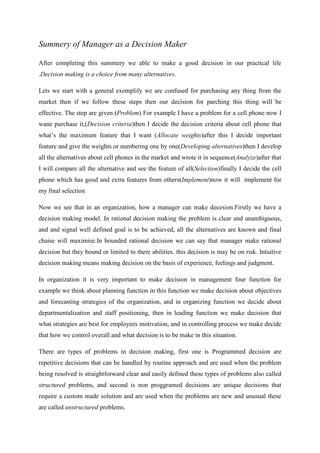
Summery of manager as a decision maker
- 1. Summery of Manager as a Decision Maker After completing this summery we able to make a good decision in our practical life .Decision making is a choice from many alternatives. Lets we start with a general exemplify we are confused for purchasing any thing from the market then if we follow these steps then our decision for parching this thing will be effective. The step are given (Problem) For example I have a problem for a cell phone now I wane purchase it,(Decision criteria)then I decide the decision criteria about cell phone that what’s the maximum feature that I want (Allocate weights)after this I decide important feature and give the weights or numbering one by one(Developing alternatives)then I develop all the alternatives about cell phones in the market and wrote it in sequence(Analyze)after that I will compare all the alternative and see the feature of all(Selection)finally I decide the cell phone which has good and extra features from others(Implement)now it will implement for my final selection Now we see that in an organization, how a manager can make decesion.Firstly we have a decision making model. In rational decision making the problem is clear and unambiguous, and and signal well defined goal is to be achieved, all the alternatives are known and final chaise will maximise.In bounded rational decision we can say that manager make rational decision but they bound or limited to there abilities. this decision is may be on risk. Intuitive decision making means making decision on the basis of experience, feelings and judgment. In organization it is very important to make decision in management four function for example we think about planning function in this function we make decision about objectives and forecasting strategies of the organization, and in organizing function we decide about departmentalization and staff positioning, then in leading function we make decision that what strategies are best for employees motivation, and in controlling process we make decide that how we control overall and what decision is to be make in this situation. There are types of problems in decision making, first one is Programmed decision are repetitive decisions that can be handled by routine approach and are used when the problem being resolved is straightforward clear and easily defined these types of problems also called structured problems, and second is non proggramed decisions are unique decisions that require a custom made solution and are used when the problems are new and unusual these are called unstructured problems.
- 2. Now there are three types of conditions on which basis a manager can make a decision, Certainty is a situation in a manager can make easily decision because all information’s are easily available, and Risk is a situation in which a manager can estimate the likelihood of certain outcomes, Uncertainty is a situation in which a manager is not known about the information but he also make decision this type of decision making condition is very danger. Linear and non linear are the decision making styles, the linear style is characterized by a persons preference for using external data and prospecting this information through rational, logical thinking. The non linear thinking style is characterized by a preference for internal sources of information’s and prospecting this information with internal insight and feelings. The 12 common errors and biases which are include overconfidence, immediate gratification,anchoring,selective perceptions,confirmation,framing,availability,representation, randomness, sunk coats, self serving bailsman hindsight
